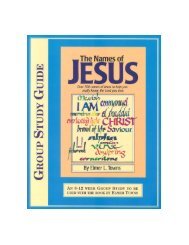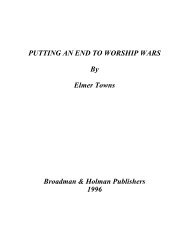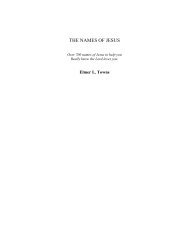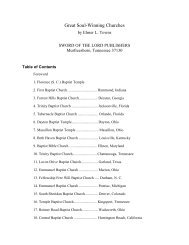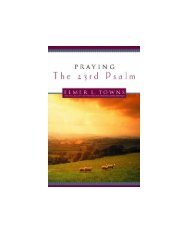A Journey Through The Old Testament - Elmer Towns
A Journey Through The Old Testament - Elmer Towns
A Journey Through The Old Testament - Elmer Towns
You also want an ePaper? Increase the reach of your titles
YUMPU automatically turns print PDFs into web optimized ePapers that Google loves.
THE CAPTURE OF LOT<br />
(Gen. 14:1-12)<br />
This chapter begins with the expression, “And it came to pass in the days of” (Gen. 14:1).<br />
<strong>The</strong>se two Hebrew words, vayehi bemeyi, occur six times in the <strong>Old</strong> <strong>Testament</strong>, always introducing<br />
a time of trouble ending with a blessing (cf. Ruth 1:1; 2 Sam. 21:1, 14; Es. 1:1; Isa. 7:1; Jer.<br />
1:3). What follows here is the identification of several rulers with names typical of the period<br />
(2000 B.C.). Over the years various attempts have been made to identify these names with<br />
known characters of that period.<br />
Amraphel, king of Shinar, was for years identified with the famous Hammurabi of<br />
Babylon. Supporting this view is the identification of Nimrod’s city-state Babel in the land of<br />
Shinar (cf. Gen. 10:10; 11:2, 9). More recently, archeologists have learned of kings named<br />
Hammurabi in Aleppo and Qurda. This appears to be a common title of that period and there<br />
may have been other rulers by that title or throne name. If this Amraphel (pronounced<br />
Hammurabi in other semitic languages) was the ruler over Nimrod’s kingdom, this would also<br />
explain why he is named first.<br />
<strong>The</strong> second king, Arioch of Ellasar, was formerly identified with Rim-Sin or Larsa but<br />
more recent archeological discoveries have resulted in a probably more accurate designation. An<br />
equivalent form of the name Arioch has been found in both Mari and Nuzi documents. <strong>The</strong> son<br />
of Zimri, Lim, king of Mari is called Aruwuk(u) and may be the Arioch mentioned here.<br />
<strong>The</strong> third king, Chedorlaomer of Elam, is virtually unknown outside of Scripture. Some<br />
scholars attempt to identify him with Katir-Nakkauti I of Elam assuming both a later date for this<br />
event and a scribal error in the text. Few commentators, however, have adopted this conclusion.<br />
<strong>The</strong> name is typical of Elamite names and means “servant of Lahamar”—an Elamite goddess.<br />
Ironically, though we know so little about this king, he may have been the dominant leader of the<br />
invading force. <strong>The</strong> Elamite dynasty was particularly strong at this time. Perhaps as archeologists<br />
uncover the ruins of Elam in the years to come, more will be learned about the actual rulers of<br />
this period.<br />
Tidal has been identified with Tudhaliya, one of five known Hittite kings. He is described<br />
here as “king of nations.” This English translation may suggest more than the Hebrew word<br />
goyim necessarily implies. <strong>Old</strong> <strong>Testament</strong> scholar, Franz Delitzsch, argues this term should be<br />
identified as an old name for Galilee (cf. Josh. 12:23; Jud. 4:2; Isa. 9:1). This suggests the Hittite<br />
kingdom dominated Galilee and that Abram’s attack at Dan (Gen. 14:14) occurred when the<br />
invading army thought their campaign was over and they were safely into their own territory.<br />
<strong>The</strong> combined strength of these four invading kings is evidenced in the nature of their<br />
military campaign. <strong>The</strong>y appear to have been primarily concerned with clearing a trading route<br />
through the Jordan Valley to the Gulf of Aqaba. <strong>The</strong> biblical account of this campaign<br />
emphasizes the spirit of rebellion on the part of the five kings of the plain of Sodom. It may be<br />
that others had also rebelled, not only failing to send tribute but also interfering with the<br />
commercial trade of the invading nations. <strong>The</strong> attack against the king of Sodom and his allies<br />
appears to be the conclusion of the campaign.<br />
Several groups are specifically identified as victims of this extended military campaign.<br />
<strong>The</strong> first of these mentioned is the Rephaim (v. 5). All that is known of this group is their notable<br />
size. <strong>The</strong> name means “long-stretched” and they were known as a tribe of giants. Some have<br />
suggested they may have been descendants of an unknown patriarch named Rapha. Others argue<br />
they were a kind of genetic mutation caused by the crossbreeding of angelic fathers and human




